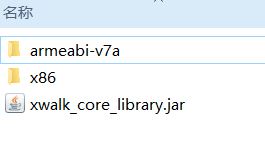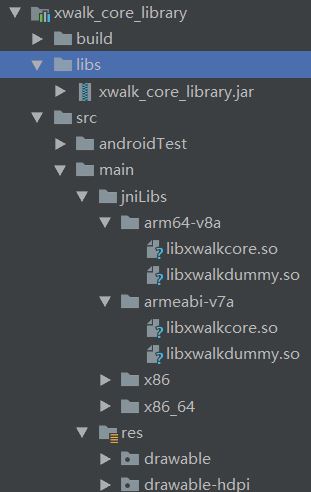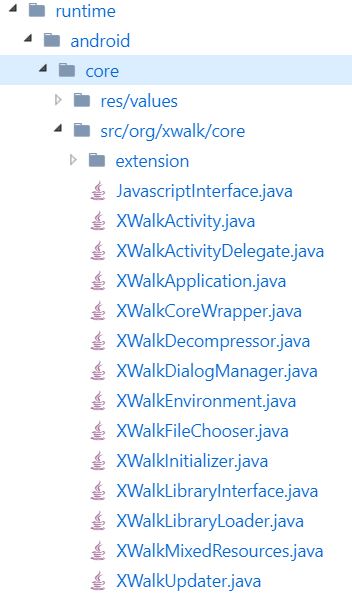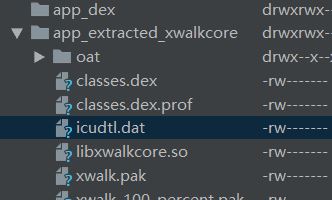简介 CrossWalk是一款为HTML应用提供运行时环境的开源项目,从Android开发的角度讲Crosswalk可以用来替代WebView显示网页,在应用重度依赖网页时可以使用Crosswalk解决设备碎片化问题。直接将Crosswalk的库包导入到项目中即可像使用WebView一样使用,这种模式在Crosswalk项目中叫内嵌模式 ,但这样有一个问题由于Crosswalk库包太大集成后的应用体积太大,为此Crosswalk为Android设备提供了另外两种使用方式,共享模式 和下载模式 。虽然Crosswalk项目17年停止维护 ,但它这种动态加载使用的方式仍值得我学习。本文将介绍Crosswalk的三种加载方式。
使用 内嵌模式 Crosswalk在它的下载地址 提供了很多资源,使用内嵌模式只需要下载对应的aar包,官方提供的aar包分为两种,一种是32位的另一种是64位,32位的aar中只包含x86和armeabi-v7a两种so文件,同理64位的包中只包含x86_64和arm64-v8a两种so文件,由于arm64-v8a平台能兼容32位的so文件、x86_64也能兼容32位的x86 so文件,在不考虑性能(暂时未知性能问题)的情况下就可以直接集成32位的aar包。需要在build.gradle文件中指定只打包32位的so文件,防止有其他依赖项目有64位的so文件,造成在运行时没有对应的crosswalk包。
1 2 3 4 5 6 7 android { defaultConfig { ndk { abiFilters 'armeabi-v7a' ,'x86' } } }
以上是内嵌模式下的一种集成方式。由于官方只提供以上2种aar,如果只想集成arm平台下的so文件或者一定要不同的平台加载对应的so文件,那只有自己新建Android library module了,到官网下载crosswalk.xx.zip和crosswalk.xx-64bit.zip,解压后如图把xwalk_core_library\libs目录下的对应so文件复制到新建的module的jniLibs下、把xwalk_core_library.jar复制到libs下,最后把xwalk_core_library\res目录下所有资源都复制到module中
由于module要对外提供xwalk_core_library.jar中的api所以要将build.gradle中依赖方式改为api
1 2 3 dependencies { api fileTree (dir: 'libs' , include: ['*.jar' ]) }
两种内嵌集成方式都可行,集成后就可以使用crosswalk了,不做任何额外操作的情况下默认是内嵌模式。在XWalkView的构造方法中会加载so文件,之后就可以使用了,和使用WebView一样XWalkUIClient对应WebView的WebChromeClient,XWalkResourceClient对应WebViewClient
共享模式 顾名思义共享模式就是和其他应用共用一个XWalkRuntime,XWalkRuntimeLib并没有被内嵌到自己的应用中,而是当应用要用到XWalkView时去加载包名为org.xwalk.core的应用的代码,如果没有安装就去下载XWalkRuntimeLib.APK安装,官方提供了两种下载APK的方式,一种是跳转Google Play Store下载,一种是在manifest文件中自定义下载链接的meta-data,到自己指定的地址去下载APK。第一种方式不可行,在大部分手机中market://details?id=xxx 这种URI跳转的是自家的应用商店,并没有XWalkRuntimeLib.APK。由于Crosswalk项目已经停止更新了,
需要在官网下载crosswalk-shared-xx.aar并将其导入到项目,让Activity继承XWalkActivity并复写它的onXWalkReady()方法,在这个方法中使用XWalkView加载网页。继承了XWalkActivity的情况下,如果不做任何配置默认的是共享模式并且是第一种方式:跳转Google Play Store下载APK。
1 2 3 4 5 6 7 8 9 10 11 12 13 14 15 16 17 18 19 20 21 22 import org.xwalk.core.XWalkActivity;import org.xwalk.core.XWalkView;public class MainActivity extends XWalkActivity XWalkView xWalkView; @Override protected void onCreate (@Nullable Bundle savedInstanceState) super .onCreate(savedInstanceState); setContentView(R.layout.activity_main); xWalkView = findViewById(R.id.xwalk); } @Override protected void onXWalkReady () xWalkView.loadUrl("https//:www.baidu.com" ); } }
第二种加载方式与第一种方式一样需要继承XWalkActivity,之后在官网下载4个平台的APK并部署到自己的服务器上,在manifest文件中配置下载路径的meta-data。
1 2 3 <meta-data android:name="xwalk_apk_url" android:value="http://192.168.1.236:8080/so/XWalkRuntimeLib.apk" />
crosswalk会自动判断手机的平台并在下载路径后添加cpuArch=xxx键值对,取值有x86、x86_64、armeabi-v7a、arm64-v8a,服务器根据不同值返回相应的APK就OK了。
下载模式 和共享模式差不多,只是共享模式是把APK下载下来当成一个应用安装到手机上,而下载模式干脆把APK下载到自己的私有目录下,把所有的so文件、资源解压出来保存到自己的内部私有目录下只供自己使用。在manifest文件中增加配置xwalk_download_mode为enable,共享模式秒变下载模式。
1 2 3 4 5 6 <meta-data android:name="xwalk_apk_url" android:value="http://192.168.1.236:8080/video/so/XWalkRuntimeLib.apk" /> <meta-data android:name="xwalk_download_mode" android:value="enable" />
除了像共享模式那样继承XWalkActivity,下载模式下还可以使用XWalkInitializer,这样就可以让Activity更灵活了,需要注意的是如果在布局中就使用了XWalkView则必须在setContentView()方法之前就要新建mXWalkInitializer对象,如果不这样做会抛错,原因是setContentView()加载布局时会初始化XWalkView,在XWalkView的构造方法中会反射加载初始化相关类,可是还没有下载相关类啊,只有抛错了。而XWalkInitializer的构造方法中会调用preInit(),这个方法就是告诉加载框架我知道还没有下载相关的类,我先在你这里注册下占个坑,如果下载初始化好了就通知我继续初始化XWalkView,共享模式中事先也没有相关的类怎么没这样的限制呢?其实在父类XWalkActivity的onCreate()方法中就帮忙注册了。下面是使用XWalkInitializer的代码:
1 2 3 4 5 6 7 8 9 10 11 12 13 14 15 16 17 18 19 20 21 22 23 24 25 26 27 28 29 30 31 32 33 34 35 36 37 38 39 40 41 42 43 44 45 46 47 48 49 50 51 52 53 54 55 56 57 58 59 60 61 62 63 64 65 66 67 public class MainActivity extends AppCompatActivity implements XWalkInitializer .XWalkInitListener , XWalkUpdater .XWalkBackgroundUpdateListener { private static final String TAG = "SplashActivity" ; XWalkInitializer mXWalkInitializer; XWalkUpdater mXWalkUpdater; XWalkView mXWalkView; @Override protected void onCreate (Bundle savedInstanceState) super .onCreate(savedInstanceState); mXWalkInitializer = new XWalkInitializer(this , this ); mXWalkInitializer.initAsync(); setContentView(R.layout.activity_splash); } @Override public void onXWalkInitStarted () } @Override public void onXWalkInitCancelled () finish(); } @Override public void onXWalkInitFailed () if (mXWalkUpdater == null ) { mXWalkUpdater = new XWalkUpdater(this , this ); } mXWalkUpdater.updateXWalkRuntime(); } @Override public void onXWalkInitCompleted () Log.d(TAG,"onXWalkInitCompleted" ); mXWalkView = findViewById(R.id.xwalk); mXWalkView.loadUrl("https://www.baidu.com" ); } @Override public void onXWalkUpdateStarted () } @Override public void onXWalkUpdateProgress (int percentage) Log.d(TAG, "XWalkUpdate progress: " + percentage); } @Override public void onXWalkUpdateCancelled () finish(); } @Override public void onXWalkUpdateFailed () finish(); } @Override public void onXWalkUpdateCompleted () mXWalkInitializer.initAsync(); } }
Crosswalk加载代码浅析 Crosswalk的全部加载代码在其Github项目地址的runtime/android/core/ 路径下,如图所示
代码不多,XWalkActivity暴露出来用于继承;XWalkActivityDelegate聚合在XWalkActivity中,将加载的逻辑和Activity的生命周期结合起来;XWalkCoreWrapper负责加载初始化so文件;官网还提供压缩版的APK,XWalkDecompressor负责解压压缩的so文件、资源;XWalkDialogManager在共享模式下为用户提供提示、选择弹窗;XWalkEnvironment提供运行环境信息,比如cpuArch、manifest中配置的参数;XWalkLibraryLoader是最主要的类,管理协调整个加载过程。而实际加载so文件、调用native方法的类在/runtime/android/core_internal/ 目录下,这也就是上文提到XWalk初始化相关类,这些类与so文件、资源一起出现,比如为内嵌模式提供的jar、aar中有internal包,而为共享、下载模式提供的包中就没有。
内嵌模式 在XWalkView的构造方法中会调用reflectionInit()方法,顾名思义也就是要去使用反射初始化类了,方法中调用XWalkCoreWrapper.initEmbeddedMode(),这个方法中会新建一个XWalkCoreWrapper对象,进而调用实例的findEmbeddedCore(),其中分别调用checkCoreVersion()、checkCoreArchitecture()确认内核的版本、so文件是否与cpuArch匹配,在checkCoreVersion()方法中调用getBridgeClass(“XWalkCoreVersion”)去反射加org.xwalk.core.internal.XWalkCoreVersion,前面提到了internal包与内核同时出现,如果加载失败了就证明“XWalk core not found”报错。XWalkCoreVersion保存的是内核版本信息、XWalkAppVersion保存的是集成的aar或jar包的版本信息,在内嵌模式中这两个没区别的。在checkCoreArchitecture()方法中加载org.xwalk.core.internal.XWalkViewDelegate的loadXWalkLibrary()方法,这个方法中才会去真正的加载so文件,由于是内嵌模式so文件的位置由系统决定,放在了data/app/package name/lib/目录下,直接调用的是 System.loadLibrary(lib)加载,最后加载成功后在XWalkView中反射初始化XWalkViewBridge以及确立XWalkView中的方法与XWalkViewBridge反射方法对应关系,比如XWalkView.loadUrl()对应的XWalkViewBridge中的loadUrlSuper()方法,完毕后就可以愉快的使用了。
1 2 3 4 5 6 7 8 9 10 11 12 13 14 15 16 17 18 19 20 21 22 23 24 25 26 27 28 29 30 31 32 33 34 35 36 37 38 39 40 41 42 43 44 45 46 47 48 49 50 51 52 53 54 55 56 57 58 59 60 61 62 63 64 65 66 67 68 69 70 71 72 73 74 75 76 77 78 79 80 81 82 83 84 85 86 87 88 89 90 91 92 93 94 95 96 97 98 99 100 101 102 103 104 105 106 107 108 109 110 111 112 113 114 115 116 117 118 119 120 121 122 123 public XWalkView (Context context, AttributeSet attrs) super (context, attrs); ...... this .reflectionInit(); } void reflectionInit () XWalkCoreWrapper.initEmbeddedMode(); } public static void initEmbeddedMode () if (sInstance != null || !sReservedActivities.isEmpty()) return ; Log.d(TAG, "Init embedded mode" ); XWalkCoreWrapper provisionalInstance = new XWalkCoreWrapper(null , -1 ); if (!provisionalInstance.findEmbeddedCore()) { throw new RuntimeException( "Please have your activity extend XWalkActivity for shared mode" ); } sInstance = provisionalInstance; sInstance.initCoreBridge(); } private boolean findEmbeddedCore () mBridgeContext = null ; mBridgeLoader = XWalkCoreWrapper.class.getClassLoader(); if (!checkCoreVersion() || !checkCoreArchitecture()) { mBridgeLoader = null ; return false ; } Log.d(TAG, "Running in embedded mode" ); mCoreStatus = XWalkLibraryInterface.STATUS_MATCH; return true ; } private boolean checkCoreVersion () Log.d(TAG, "[Environment] SDK:" + Build.VERSION.SDK_INT); Log.d(TAG, "[App Version] build:" + XWalkAppVersion.XWALK_BUILD_VERSION + ", api:" + mApiVersion + ", min_api:" + mMinApiVersion); try { Class<?> clazz = getBridgeClass("XWalkCoreVersion" ); String buildVersion = "" ; try { buildVersion = (String) new ReflectField(clazz, "XWALK_BUILD_VERSION" ).get(); } catch (RuntimeException e) { } int libVersion = (int ) new ReflectField(clazz, "API_VERSION" ).get(); int minLibVersion = (int ) new ReflectField(clazz, "MIN_API_VERSION" ).get(); Log.d(TAG, "[Lib Version] build:" + buildVersion + ", api:" + libVersion + ", min_api:" + minLibVersion); if (XWalkEnvironment.isDownloadMode() && XWalkEnvironment.isDownloadModeUpdate() && !buildVersion.isEmpty() && !buildVersion.equals(XWalkAppVersion.XWALK_BUILD_VERSION)) { mCoreStatus = XWalkLibraryInterface.STATUS_RUNTIME_MISMATCH; return false ; } if (mMinApiVersion > libVersion) { mCoreStatus = XWalkLibraryInterface.STATUS_OLDER_VERSION; return false ; } else if (mApiVersion < minLibVersion) { mCoreStatus = XWalkLibraryInterface.STATUS_NEWER_VERSION; return false ; } } catch (RuntimeException e) { Log.d(TAG, "XWalk core not found" ); mCoreStatus = XWalkLibraryInterface.STATUS_NOT_FOUND; return false ; } Log.d(TAG, "XWalk core version matched" ); return true ; } private boolean checkCoreArchitecture () try { Class<?> clazz = getBridgeClass("XWalkViewDelegate" ); ReflectMethod method = new ReflectMethod(clazz, "loadXWalkLibrary" , Context.class, String.class); boolean architectureMatched = false ; String libDir = null ; if (mBridgeContext != null ) { ....... } else { try { architectureMatched = (boolean ) method.invoke(mBridgeContext, libDir); } catch (RuntimeException ex) { Log.d(TAG, ex.getLocalizedMessage()); } if (!architectureMatched && mWrapperContext != null ) { libDir = XWalkEnvironment.getPrivateDataDir(); architectureMatched = (boolean ) method.invoke(mBridgeContext, libDir); } } if (!architectureMatched) { Log.d(TAG, "Mismatch of CPU architecture" ); mCoreStatus = XWalkLibraryInterface.STATUS_ARCHITECTURE_MISMATCH; return false ; } } catch (RuntimeException e) { Log.d(TAG, e.getLocalizedMessage()); if (e.getCause() instanceof UnsatisfiedLinkError) { mCoreStatus = XWalkLibraryInterface.STATUS_ARCHITECTURE_MISMATCH; return false ; } mCoreStatus = XWalkLibraryInterface.STATUS_INCOMPLETE_LIBRARY; return false ; } Log.d(TAG, "XWalk core architecture matched" ); return true ; }
内嵌模式的加载就这些,一句话:在第一次新建XWalkView对象时就去通过反射加载so文件。同一个包中为什么不直接调用,而用反射去加载?这就是为了和接下来要说的共享、下载模式统一。
共享模式 1、跳转Google Play 下载 共享模式需要继承XWalkActivity,在onCreate()方法中会新建XWalkActivityDelegate对象
1 2 3 4 5 6 7 8 9 10 11 12 13 14 15 16 17 18 19 20 21 22 23 24 25 26 27 28 29 30 31 32 33 34 35 36 37 38 public abstract class XWalkActivity extends Activity private XWalkActivityDelegate mActivityDelegate; @Override protected void onCreate (Bundle savedInstanceState) super .onCreate(savedInstanceState); mActivityDelegate = new XWalkActivityDelegate(this , cancelCommand, completeCommand); } } public XWalkActivityDelegate (Activity activity, Runnable cancelCommand, Runnable completeCommand) mActivity = activity; XWalkLibraryLoader.prepareToInit(mActivity); } public static void prepareToInit (Context context) XWalkEnvironment.init(context); XWalkCoreWrapper.handlePreInit(context.getClass().getName()); } public static void handlePreInit (String tag) if (sInstance != null ) return ; Log.d(TAG, "Pre init xwalk core in " + tag); if (sReservedActions.containsKey(tag)) { sReservedActions.remove(tag); } else { sReservedActivities.add(tag); } sReservedActions.put(tag, new LinkedList<ReservedAction>()); } private static HashMap<String, LinkedList<ReservedAction> > sReservedActions = new HashMap<String, LinkedList<ReservedAction> >(); private static LinkedList<String> sReservedActivities = new LinkedList<String>();
这样preInit添加到sReservedActions后,setContentView中去初始化XWalkView时就不会报错了,为什么不报错了?看下面初始化XWalkView的具体过程:
1 2 3 4 5 6 7 8 9 10 11 12 13 14 15 16 17 18 19 20 21 22 23 24 25 26 27 28 29 30 31 32 33 34 35 36 37 public XWalkView (Context context, AttributeSet attrs) super (context, attrs); ...... this .reflectionInit(); } initEmbeddedMode,但sReservedActivities不为空直接返回了;虽然调用了 若干XWalkCoreWrapper静态方法,但是设计的原则是开始初始化才会新建私有的 XWalkCoreWrapper对象、初始化完才会暴露这个私有对象,这时并没有初始化内核 XWalkCoreWrapper.getInstance()为空, 不会继续初始化XWalkView了,XWalkCoreWrapper.reserveReflectObject(this )注册占坑,等待下载内核。 void reflectionInit () XWalkCoreWrapper.initEmbeddedMode(); this .coreWrapper = XWalkCoreWrapper.getInstance(); if (this .coreWrapper == null ) { XWalkCoreWrapper.reserveReflectObject(this ); } else { ...... } } public static void initEmbeddedMode () if (sInstance != null || !sReservedActivities.isEmpty()) return ; } tag,为什么取最近的呢?是因为默认继承XWalkActivity的Activity中的onCreate方法 中调用了super ()之后立即就setContentView了,线程执行的最小粒度就是方法了, 不可能在这时会有同一线程的其他方法向sReservedActivities添加tag。之后拿到tag后向sReservedActions添加反射类,用于加载完内核后执行 public static void reserveReflectObject (Object object) String tag = (String)sReservedActivities.getLast(); Log.d("XWalkLib" , "Reserve object " + object.getClass() + " to " + tag); ((LinkedList)sReservedActions.get(tag)).add(new XWalkCoreWrapper.ReservedAction(object)); }
上面实际上是初始化XWalkView未遂的过程,虽然XWalkView对象有了,但它只是一个没有灵魂的壳,不能立即使用,还得等待下载内核,下载是在XWalkActivityDelegate的onResume()方法中开始的,下面是XWalkActivityDelegate的onResume()方法:
1 2 3 4 5 6 7 8 9 10 11 12 13 14 public void onResume () if (mIsXWalkReady) return ; if (XWalkLibraryLoader.isInitializing() || XWalkLibraryLoader.isDownloading()) { Log.d(TAG, "Other initialization or download is proceeding" ); return ; } Log.d(TAG, "Initialize by XWalkActivity" ); XWalkLibraryLoader.startDecompress(this ); } public static void startDecompress (DecompressListener listener) new DecompressTask(listener).execute(); }
DecompressTask之后会调用ActivateTask,内核都没下载这些都是徒劳,最后会得一个
1 2 3 4 5 6 7 8 9 10 11 12 13 14 15 16 17 18 19 20 21 22 23 24 25 26 27 28 29 30 31 32 33 34 35 36 37 38 39 40 41 42 43 44 45 46 @Override public void onActivateFailed () if (mXWalkUpdater == null ) { if (XWalkEnvironment.isDownloadMode()) { mXWalkUpdater = new XWalkUpdater( new XWalkBackgroundUpdateListener() { @Override public void onXWalkUpdateStarted () } @Override public void onXWalkUpdateProgress (int percentage) } @Override public void onXWalkUpdateCancelled () mCancelCommand.run(); } @Override public void onXWalkUpdateFailed () mCancelCommand.run(); } @Override public void onXWalkUpdateCompleted () XWalkLibraryLoader.startActivate(XWalkActivityDelegate.this ); } }, mActivity); } else { mXWalkUpdater = new XWalkUpdater( new XWalkUpdateListener() { @Override public void onXWalkUpdateCancelled () mCancelCommand.run(); } }, mActivity, mDialogManager); } } if (mXWalkUpdater.updateXWalkRuntime() && !XWalkEnvironment.isDownloadMode()) { 。。。。。。 } } }
这是共享模式,新建XWalkUpdater对象调用它的updateXWalkRuntime()下载,共享模式会弹一个窗告诉用户去下载,ok后调用downloadXWalkApk()。下面是XWalkUpdater的updateXWalkRuntime()
1 2 3 4 5 6 7 8 9 10 11 12 13 14 15 16 17 18 19 20 21 22 23 24 25 public boolean updateXWalkRuntime () if (mUpdateListener != null ) { mDownloadCommand = new Runnable() { @Override public void run () downloadXWalkApk(); } }; mCancelCommand = new Runnable() { @Override public void run () Log.d(TAG, "XWalkUpdater cancelled" ); mUpdateListener.onXWalkUpdateCancelled(); } }; mDialogManager.showInitializationError(status, mCancelCommand, mDownloadCommand); } else if (mBackgroundUpdateListener != null ) { String url = XWalkEnvironment.getXWalkApkUrl(); XWalkLibraryLoader.startHttpDownload(new BackgroundListener(), mContext, url); } else { throw new IllegalArgumentException("Update listener is null" ); } return true ; }
下载APK,如果在meta-data中配置了下载地址就使用这个地址下载APK,否则
1 2 3 4 5 6 7 8 9 10 11 12 13 14 15 16 17 18 19 20 21 22 23 24 25 26 27 28 29 30 31 32 33 34 35 private void downloadXWalkApk () String url = XWalkEnvironment.getXWalkApkUrl(); if (!url.isEmpty()) { XWalkLibraryLoader.startDownloadManager(new ForegroundListener(), mContext, url); return ; } String packageName = "org.xwalk.core" ; final Intent intent = new Intent("android.intent.action.VIEW" ); intent.setData(Uri.parse("market://details?id=" + packageName)); List<ResolveInfo> infos = mContext.getPackageManager().queryIntentActivities( intent, PackageManager.MATCH_ALL); StringBuilder supportedStores = new StringBuilder(); boolean hasGooglePlay = false ; ...... 如果是IA架构包名也得改 if (!hasGooglePlay && XWalkEnvironment.isIaDevice()) { if (XWalkEnvironment.is64bitApp()) { packageName = "org.xwalk.core64.ia" ; } else { packageName = "org.xwalk.core.ia" ; } } else if (XWalkEnvironment.is64bitApp()) { packageName = "org.xwalk.core64" ; } else { packageName = "org.xwalk.core" ; } Log.d(TAG, "Package name of Crosswalk to download: " + packageName); ...... }
这里判断架构、位数的代码值得借鉴。分为两个方法,一个是getRuntimeAbi()
1 2 3 4 5 6 7 8 9 10 11 12 13 14 15 16 17 18 19 20 21 22 23 24 25 26 27 28 29 30 31 32 33 34 35 36 37 38 39 40 41 42 43 44 45 46 47 48 49 50 51 52 53 54 55 56 57 58 59 60 61 62 63 64 65 66 67 68 69 70 71 72 73 74 75 76 77 78 79 80 81 82 83 84 85 86 87 88 89 90 91 92 93 94 95 96 97 98 99 100 public static String getRuntimeAbi () if (sRuntimeAbi == null ) { try { if (Build.VERSION.SDK_INT >= Build.VERSION_CODES.LOLLIPOP) { throw new NoSuchFieldError(); } String abi = Build.CPU_ABI.toLowerCase(); switch (abi) { case "armeabi" : case "armeabi-v7a" : sRuntimeAbi = "armeabi-v7a" ; break ; case "arm64-v8a" : sRuntimeAbi = "arm64-v8a" ; break ; case "x86" : sRuntimeAbi = "x86" ; break ; case "x86_64" : sRuntimeAbi = "x86_64" ; break ; default : throw new RuntimeException("Unexpected CPU_ABI: " + abi); } } catch (NoSuchFieldError e) { String arch = System.getProperty("os.arch" ).toLowerCase(); switch (arch) { case "x86" : case "i686" : case "i386" : case "ia32" : sRuntimeAbi = "x86" ; break ; case "x64" : case "x86_64" : if (is64bitDevice()) { sRuntimeAbi = "x86_64" ; } else { sRuntimeAbi = "x86" ; } break ; case "armv7l" : case "armeabi" : case "armeabi-v7a" : sRuntimeAbi = "armeabi-v7a" ; break ; case "aarch64" : case "armv8" : case "armv8l" : case "arm64" : if (is64bitDevice()) { sRuntimeAbi = "arm64-v8a" ; } else { sRuntimeAbi = "armeabi-v7a" ; } break ; default : throw new RuntimeException("Unexpected os.arch: " + arch); } } if (sRuntimeAbi.equals("armeabi-v7a" )) { if (isIaDevice()) { sRuntimeAbi = "x86" ; } } else if (sRuntimeAbi.equals("arm64-v8a" )) { if (isIaDevice()) { sRuntimeAbi = "x86_64" ; } } Log.d(TAG, "Runtime ABI: " + sRuntimeAbi); } return sRuntimeAbi; } public static String getDeviceAbi () if (sDeviceAbi == null ) { try { sDeviceAbi = Build.SUPPORTED_ABIS[0 ].toLowerCase(); } catch (NoSuchFieldError e) { try { Process process = Runtime.getRuntime().exec("getprop ro.product.cpu.abi" ); InputStreamReader ir = new InputStreamReader(process.getInputStream()); BufferedReader input = new BufferedReader(ir); sDeviceAbi = input.readLine().toLowerCase(); input.close(); ir.close(); } catch (IOException ex) { throw new RuntimeException("Can not detect device's ABI" ); } } Log.d(TAG, "Device ABI: " + sDeviceAbi); } return sDeviceAbi; }
2、自定义下载链接 流程与跳转商店下载是一样的,只是到了downloadXWalkApk()方法时url不为空了,
安装成功后,手机上就会有一个包名为org.xwalk.core的应用了,这个应用没有提供入口,桌面没图标。这时重新打开自己的应用还是会走上面的流程,只是到了ActiveTask时会执行XWalkCoreWrapper.attachXWalkCore(),过程如下:
1 2 3 4 5 6 7 8 9 10 11 12 13 14 15 16 17 18 19 20 21 22 23 24 25 26 27 28 29 30 31 32 33 34 35 36 37 38 39 40 41 42 43 44 45 46 47 48 49 50 51 52 53 54 55 56 57 58 59 60 public static int attachXWalkCore () ...... sProvisionalInstance = new XWalkCoreWrapper(XWalkEnvironment.getApplicationContext(), 1 ); if (XWalkEnvironment.is64bitDevice()) { if (!sProvisionalInstance.findSharedCore("org.xwalk.core" ) && !sProvisionalInstance.findSharedCore("org.xwalk.core64" ) && XWalkEnvironment.isIaDevice()) { sProvisionalInstance.findSharedCore("org.xwalk.core64.ia" ); } } else if (!sProvisionalInstance.findSharedCore("org.xwalk.core" ) && XWalkEnvironment.isIaDevice()) { sProvisionalInstance.findSharedCore("org.xwalk.core.ia" ); } return sProvisionalInstance.mCoreStatus; } private boolean findSharedCore (String packageName) if (!checkCorePackage(packageName)) return false ; mBridgeLoader = mBridgeContext.getClassLoader(); if (!checkCoreVersion() || !checkCoreArchitecture()) { mBridgeContext = null ; mBridgeLoader = null ; return false ; } Log.d(TAG, "Running in shared mode" ); mCoreStatus = XWalkLibraryInterface.STATUS_MATCH; return true ; } private boolean checkCorePackage (String packageName) if (XWalkAppVersion.VERIFY_XWALK_APK) { try { PackageInfo packageInfo = mWrapperContext.getPackageManager().getPackageInfo( packageName, PackageManager.GET_SIGNATURES); if (!verifyPackageInfo(packageInfo, XWalkAppVersion.XWALK_APK_HASH_ALGORITHM, XWalkAppVersion.XWALK_APK_HASH_CODE)) { Log.d(TAG, packageName + " signature verification failed" ); mCoreStatus = XWalkLibraryInterface.STATUS_SIGNATURE_CHECK_ERROR; return false ; } } catch (NameNotFoundException e) { Log.d(TAG, packageName + " not found" ); return false ; } } try { mBridgeContext = mWrapperContext.createPackageContext(packageName, Context.CONTEXT_INCLUDE_CODE | Context.CONTEXT_IGNORE_SECURITY); } catch (NameNotFoundException e) { Log.d(TAG, packageName + " not found" ); return false ; } Log.d(TAG, "Created package context for " + packageName); return true ; }
之后调用checkCoreVersion()、checkCoreArchitecture()确认版本、加载so文件,完毕后回到ActiveTask,激活成功了调用XWalkLibraryLoader.finishInit(this.mActivity)
1 2 3 4 5 6 7 8 9 10 11 12 13 14 15 16 17 18 19 20 21 22 23 24 public static void finishInit (Context context) XWalkCoreWrapper.handlePostInit(context.getClass().getName()); } public static void handlePostInit (String tag) Log.d(TAG, "Post init xwalk core in " + tag); if (!sReservedActions.containsKey(tag)) { return ; } LinkedList<ReservedAction> reservedActions = sReservedActions.get(tag); for (ReservedAction action : reservedActions) { if (action.mObject != null ) { Log.d(TAG, "Init reserved object: " + action.mObject.getClass()); new ReflectMethod(action.mObject, "reflectionInit" ).invoke(); } ... action.mMethod.invoke(args); } } sReservedActions.remove(tag); sReservedActivities.remove(tag); }
看了这个流程大概明白了为什么代码要混淆了,如果不混淆在知道详细代码的情况下就可以反射调用代码。
下载模式 1、继承XWalkActivity 这种方式与共享模式是一样的,onActivateFailed()方法中会判断是否是下载模式,依据就是manifest文件中xwalk_download_mode=enable,是下载模式就不弹窗了直下载,最后调用HttpDownloadTask将APK下载到内部私有目录xwalk_download下,下载完毕后把APK中的classes.dex、资源使用XWalkDecompressor对象解压到内部私有目录extracted_xwalkcore下,解压完毕继续走ActiveTask的流程,和上面一样了,只是ClassLoader不通过context创建,而是新建DexClassLoader
1 2 3 4 5 6 7 8 9 10 11 12 13 14 15 private boolean findDownloadedCore () String libDir = XWalkEnvironment.getExtractedCoreDir(); String dexPath = libDir + File.separator + "classes.dex" ; String dexOutputPath = XWalkEnvironment.getOptimizedDexDir(); ClassLoader localClassLoader = ClassLoader.getSystemClassLoader(); this .mBridgeLoader = new DexClassLoader(dexPath, dexOutputPath, libDir, localClassLoader); if (this .checkCoreVersion() && this .checkCoreArchitecture()) { Log.d("XWalkLib" , "Running in downloaded mode" ); this .mCoreStatus = 1 ; return true ; } else { this .mBridgeLoader = null ; return false ; } }
2、使用XWalkInitializer XWalkInitializer与XWalkActivityDelegate的作用是一样的,只是后者把所有的逻辑
Crosswalk的学习笔记完,如有不正确的地方,欢迎多多指教!



